Modulatory mechanisms and multiple functions of somatodendritic A-type K (+) channel auxiliary subunits
- PMID: 24723849
- PMCID: PMC3973911
- DOI: 10.3389/fncel.2014.00082
Modulatory mechanisms and multiple functions of somatodendritic A-type K (+) channel auxiliary subunits
Abstract
Auxiliary subunits are non-conducting, modulatory components of the multi-protein ion channel complexes that underlie normal neuronal signaling. They interact with the pore-forming α-subunits to modulate surface distribution, ion conductance, and channel gating properties. For the somatodendritic subthreshold A-type potassium (ISA) channel based on Kv4 α-subunits, two types of auxiliary subunits have been extensively studied: Kv channel-interacting proteins (KChIPs) and dipeptidyl peptidase-like proteins (DPLPs). KChIPs are cytoplasmic calcium-binding proteins that interact with intracellular portions of the Kv4 subunits, whereas DPLPs are type II transmembrane proteins that associate with the Kv4 channel core. Both KChIPs and DPLPs genes contain multiple start sites that are used by various neuronal populations to drive the differential expression of functionally distinct N-terminal variants. In turn, these N-terminal variants generate tremendous functional diversity across the nervous system. Here, we focus our review on (1) the molecular mechanism underlying the unique properties of different N-terminal variants, (2) the shaping of native ISA properties by the concerted actions of KChIPs and DPLP variants, and (3) the surprising ways that KChIPs and DPLPs coordinate the activity of multiple channels to fine-tune neuronal excitability. Unlocking the unique contributions of different auxiliary subunit N-terminal variants may provide an important opportunity to develop novel targeted therapeutics to treat numerous neurological disorders.
Keywords: Kv channel-interacting protein; N-terminal variant; auxiliary subunit; dipeptidyl peptidase-like protein; excitability; modulatory mechanism; potassium channel; somatodendritic A-type current.
Figures
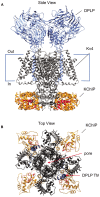

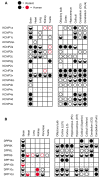
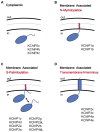
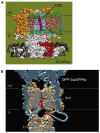
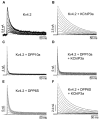


Similar articles
-
Convergent modulation of Kv4.2 channel alpha subunits by structurally distinct DPPX and KChIP auxiliary subunits.Biochemistry. 2009 Jun 23;48(24):5721-30. doi: 10.1021/bi802316m. Biochemistry. 2009. PMID: 19441798 Free PMC article.
-
The neuronal Kv4 channel complex.Neurochem Res. 2008 Aug;33(8):1558-67. doi: 10.1007/s11064-008-9650-8. Epub 2008 Mar 21. Neurochem Res. 2008. PMID: 18357523 Free PMC article. Review.
-
Different KChIPs compete for heteromultimeric assembly with pore-forming Kv4 subunits.Biophys J. 2015 Jun 2;108(11):2658-69. doi: 10.1016/j.bpj.2015.04.024. Biophys J. 2015. PMID: 26039167 Free PMC article.
-
Multiple Kv channel-interacting proteins contain an N-terminal transmembrane domain that regulates Kv4 channel trafficking and gating.J Biol Chem. 2008 Dec 19;283(51):36046-59. doi: 10.1074/jbc.M806852200. Epub 2008 Oct 28. J Biol Chem. 2008. PMID: 18957440 Free PMC article.
-
[Modulation of Kv4 channels by KChIPs clamping].Sheng Li Ke Xue Jin Zhan. 2009 Jan;40(1):9-13. Sheng Li Ke Xue Jin Zhan. 2009. PMID: 19408696 Review. Chinese.
Cited by
-
Enhanced Sensitivity to Hyperpolarizing Inhibition in Mesoaccumbal Relative to Nigrostriatal Dopamine Neuron Subpopulations.J Neurosci. 2017 Mar 22;37(12):3311-3330. doi: 10.1523/JNEUROSCI.2969-16.2017. Epub 2017 Feb 20. J Neurosci. 2017. PMID: 28219982 Free PMC article.
-
Single-cell analysis of chromatin and expression reveals age- and sex-associated alterations in the human heart.Commun Biol. 2024 Aug 26;7(1):1052. doi: 10.1038/s42003-024-06582-y. Commun Biol. 2024. PMID: 39187646 Free PMC article.
-
R-type voltage-gated Ca2+ channels mediate A-type K+ current regulation of synaptic input in hippocampal dendrites.Cell Rep. 2022 Jan 18;38(3):110264. doi: 10.1016/j.celrep.2021.110264. Cell Rep. 2022. PMID: 35045307 Free PMC article.
-
SUMOylating Two Distinct Sites on the A-type Potassium Channel, Kv4.2, Increases Surface Expression and Decreases Current Amplitude.Front Mol Neurosci. 2019 May 31;12:144. doi: 10.3389/fnmol.2019.00144. eCollection 2019. Front Mol Neurosci. 2019. PMID: 31213982 Free PMC article.
-
Functional specification of CCK+ interneurons by alternative isoforms of Kv4.3 auxiliary subunits.Elife. 2020 Jun 3;9:e58515. doi: 10.7554/eLife.58515. Elife. 2020. PMID: 32490811 Free PMC article.
References
Publication types
LinkOut - more resources
Full Text Sources
Other Literature Sources

